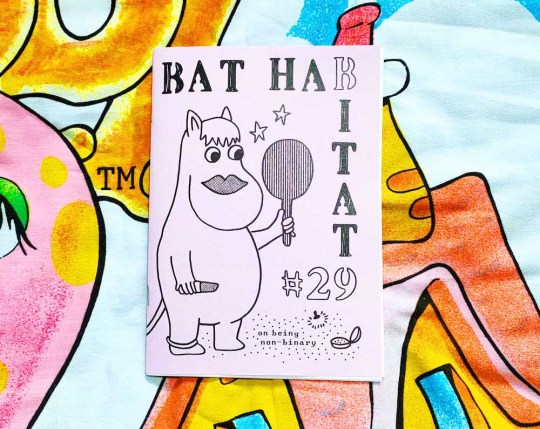#Bat Habitat zine
Explore tagged Tumblr posts
Text



'Bat Habitat - on being non-binary' is a queer perzine by zinester Tukru. Buy issue 29 (pictured) on their Etsy.
#zine#zines#fanzine#fanzines#Bat Habitat zine#Bat Habitat fanzine#Tukru#queer zine#queerzine#queer zines#queerzines#perzine#perzines#non-binary#non-binary zine#non-binary fanzine#non-binary perzine#non-binary queer zine#Bat Habitat - on being non-binary#etsy
94 notes
·
View notes
Text
Summer Bloom Spotlight: Heliconia

Heliconia refers to a group of 200 species of exotic looking plants native to the tropical Americas, though some species are found in the Pacific Ocean. They are known for their bold multi-colour bracts (modified leaves which are commonly mistaken for the flowers themselves) and small hidden flowers within their leaves.
The Heliconia is named after Mount Helicon, a mountain in the south of Greece, which is said to be the homeplace of the Muses - Greek Goddesses of inspiration in the fields of the arts, literature and science. The plant also has other common names such as the “False Bird of Paradise” due to their similarity to Strelitzia flowers (which also go by the name Bird of Paradise), as well as “Lobster Claw” in reference to the shape of its bracts.
The plant is one of the national flowers of Bolivia, and is commonly cultivated for ornamental purposes due to its desirable appearance.
Heliconias are also very well suited to the wildlife in their habitats. They are pollinated by bats and birds, instead of insects like you would expect with most flowers, and their leaves collect small water reverses for mosquitoes and frogs. Various species of Heliconia are adapted specifically to the animals in their environment, and produce an abundance of nectar. Their bracts, which contain this nectar, are shaped so that only certain birds are able to reach the flowers within. They also open their leaves at night to attract bats (who locate food using chemical cues instead of sight), who may also roost in their long leaves.
The Heliconia is a symbol of youth, pride and great returns.
Find the Heliconia interesting? Let us know, and consider signing up to take part in the Summer Blooms Zine when applications open on April 20th!
[image credit: Ted’s Photos - For Me For You]
#summerbloomszine#zine#new zine#floral#floral zine#flower#flowers#flower meanings#flower language#flower symbolism#heliconia#heliconias#summerbloomspotlights#zine ideas#inspiration#zine inspiration#open zine#writing prompts#art prompts
7 notes
·
View notes
Photo


QUARANZINE #96 QUARANZINE #96: Deep Time Chicago. As I reach 100 issues (my stopping point, at least for now), it's clear that if I published 10,000 issues I still probably wouldn't cover nearly all that could be written about this pandemic. Still, the project has been a little short on writings about ecological science and today's zine helps address that lack. Thanks to my friend and issue contact Sara Black and Deep Time Chicago for stepping out of the forest and into print for this issue, which explores the ecological roots of the pandemic and what frogs have to do with what we are experiencing.
Full text: Forest Connection by Deep Time Chicago
Someday we’ll find it The Rainbow Connection The lovers, the dreamers and me
- Kermit the Frog
Forests visibly exclaim connections between beings and systems. Fallen trees open up light in the canopy for abundant new growth. Decaying trees feed the wood-loving mushrooms whose mycelium holds moisture for the mature tree stand. Insects perform the externalized sex-act of plants through cross-pollination. Birds, bats, and frogs feast on those insects and become food for larger mammal species or make abundant waste to enrich the soil with microbes.
For some Chicago folx, the forests have become a place of refuge during the months of shelter-in-place. For others, a full alienation from green spaces has become, or already was, the norm. In the early weeks of shelter-in-place, Deep Time Chicago began to study the ecological roots of the pandemic. Two texts provided the playbook for SARS-CoV-2 (COVID-19): Big Farms Make Big Flu: Dispatches on Influenza, Agribusiness, and the Nature of Science by Rob Wallace and Spillover: Animal Infections and the Next Human Pandemic by David Quammen. Both of these works led us to the forest, where the practices of the Anthropocene continue human patterns of disruption to arboreal ecosystems and make a pandemic of this scale inevitable.
Analogous to the canary in the coal mine, frogs are a marquee species, announcing through population collapse that we are in the midst of a mass extinction. The Black-Eyed Tree frog, a real world referent for Kermit the Frog, and a sentinel species in the forests of Belize, El Salvador, Guatemala, Honduras, and Mexico, is nearly extinct due to two anthropogenic stressors: rapid habitat loss from deforestation, and exposure to Chytridiomycosis, a fungal pathogen globally spread through trade of wild amphibians. A pandemic. In the past 30 years, more than 200 frog species worldwide have gone extinct due to this pathogen; 300 more are in rapid decline. The fungus thickens the skin and hinders the absorption of water and oxygen - frogs breathe through their skin - which leads to multiple organ failure. Similarly, in severe cases of COVID-19, human lungs fill with fluid and impair oxygen exchange, leading to multiple organ failure. We need to find the connection.
It turns out that SARS-CoV-2 is also of-the-forest. Not only are forests reservoirs of CO2, they are the safe harbors of diverse species of bacteria and viruses, potentially pathogenic microorganisms that are highly capable and adaptive, with long complex genealogies. Microorganisms hang out in abundant diversity in forest ecologies, but they do not perambulate. They need a host to carry them. Companion species, or reservoir hosts, which could be bats, mosquitoes, gorillas, rats, or frogs, live comfortably with pathogens without any adverse effects, even with viruses as deadly to humans as HIV (AIDS), H1N1 (Spanish Flu), or SARS-CoV-2.
Our most dangerous interactions with these microbes come from continued forest disturbances by humans, which send previously symbiotic microbial balances into new species contact. Deforestation for industrial scale agriculture or timber extraction puts immense pressure on wild animals already compromised through increased habitat loss. Local populations, in search of resources, hunt or subsistence farm in greater territory ranges. Reservoir species that may carry a virus without harm are increasingly likely to come into contact with domestic species such as pigs, poultry, horses or even humans. When a viral pathogen enters a new species, it is called a spillover. When a pathogen jumps, the spillover species can also act as an amplifier of the disease, rendering it even more deadly.
Industrially farmed chickens and hogs are excellent amplifiers, as they are packed into confined spaces where cross transmission is easy and immunity is low. When a virus, fungus, or bacterium reaches humans, it is well poised to travel on trucks, ships or planes, whether we are an infected biological vector or carrying the pathogen on commodified goods. With Chytridiomycosis, humans carried the pathogen around the globe on commodified frog species; in the case of SARS-CoV-2, we are carrying it within us.
Amidst the suffering born of COVID-19, we naturally speak a great deal about possible responses and seek to assign blame. We look to medicine and government for containment, treatment, and the hope of a vaccine. When seeking causes, the appearance of this virus is treated as “novel”, a surprise, a natural disaster, or politicized through conspiratorial frameworks of lab-engineered bioweapons and xenophobia. But we are not separate from the ecosystems we decimate. We are accountable for how these microbes are spread. These wild beings and these forests are here now, in our communities and in our bodies. Someday very soon, like today, we had better find the connection.
#QUARANZINE#Deep Time Chicago#Public Collectors#Marc Fischer#coronavirus#covid-19#frogs#zine#zines#Publications#RISO#one-page zine
10 notes
·
View notes
Photo

The charity the 2019 No. 6 Zine will be supporting is the Pollinator Partnership!
The Pollinator Partnership is working to protect pollinators and their habitat with projects all over North America and globally. Their mission is to promote the health of pollinators, critical to food and ecosystems, through conservation, education, and research. Pollinators include bees, wasps, butterflies, moths, birds, bats, and small mammals.
This charity was chosen because it helps conserve bees, which are important to the story of No. 6. All profits from the 2019 No. 6 Zine will be donated to Pollinator Partnership. Last year we raised 694$ for charity. Let’s see if we can raise even more this year!
57 notes
·
View notes
Text
The Curse of the Couture: Castlevania Fanzine dates and charity have been officially chosen!
Firstly, our official dates have been picked! The zine artwork deadline is June 1st with pre-orders opening June 1st, and orders being sent out to ship July 1st. The month of June will be spent on zine formatting, with updates continuing until the final shipping dates! This allows no more extensions, giving a hard set date for all artists to follow.
Secondly, the zine charity has been chosen! After all of our contributors voted, we have formally decided upon donating all proceeds of the zine towards Bat Conservation International!
This wonderful charity is dedicated to protecting bats around the world. Bats are animals who are incredibly important to the ecosystem and deeply intertwined with Castlevania itself. Bat Conservation International has several initiatives, including preventing bat extinctions, protecting bat habitats, and awarding thousands in scholarships to those dedicated to bat research.
Bat Conservation International also continues to use over 75% of all proceeds towards their initiatives. This ensures that the money we donate actually goes to these bat-specific causes the Castlevania community supports, and not towards higher ups.
We hope this information is exciting to everyone interested in this zine! Our mods and all contributors are incredibly dedicated, and we are all very excited for the end product. If you have any questions or concerns, please feel free to send in an ask!
23 notes
·
View notes